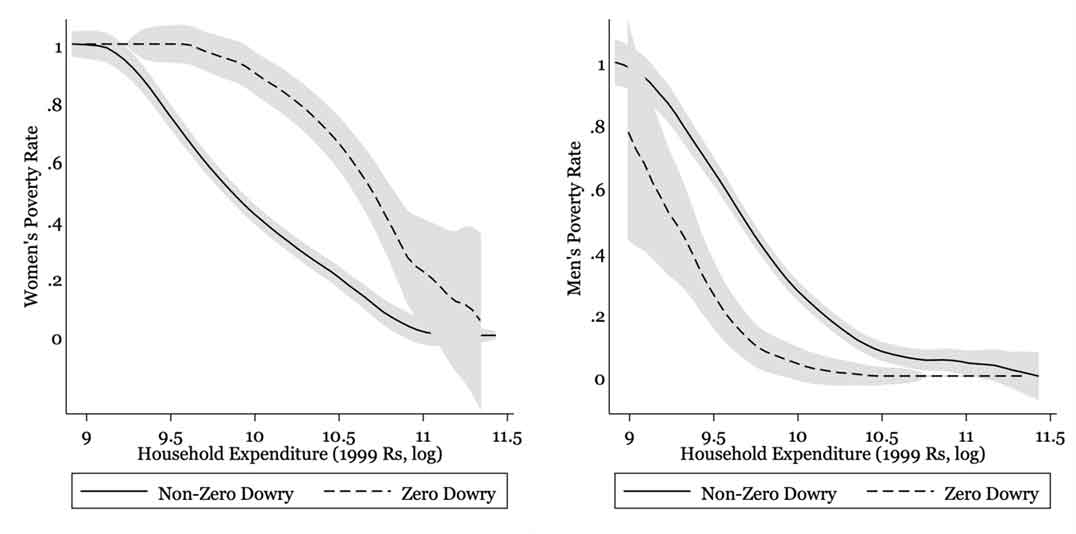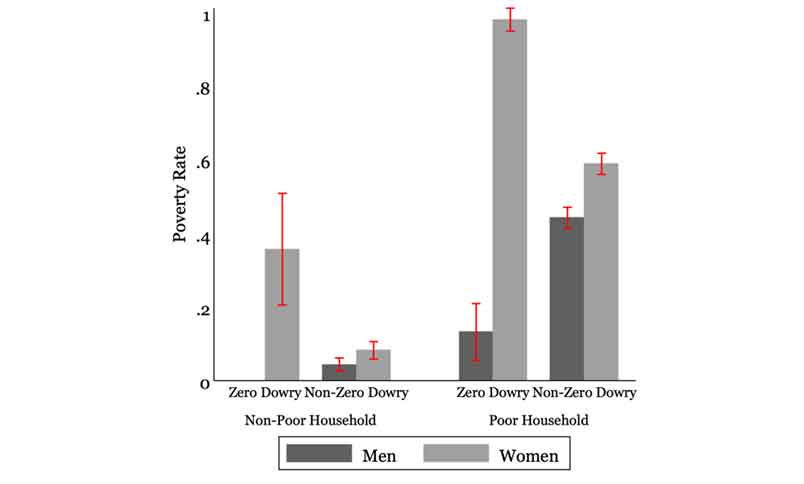Dowries are transfers of wealth from the bride's family to the groom or his family at the time of marriage. Analysing nationally representative survey data from rural India, this article shows that dowries can influence women's well-being post marriage: brides who do not pay dowry have lower control over household expenditures and are at higher risk of living in poverty. So, well-intentioned anti-dowry policies could unintentionally worsen women's post-marital status.
Dowries are transfers of material wealth from the bride’s family to the groom or his family at the time of marriage. Historically, dowries served as a pre-mortem bequest to a daughter, especially in patrilineal and patrilocal societies where male children inherit the family wealth and a couple typically resides with or near the husband’s parents (Botticini and Siow 2003). In India, dowries have transitioned from a way of endowing daughters with economic safety to a ‘groom price’ – a transfer of wealth from the bride’s parents to the groom or his family, with the bride having limited rights over it (Srinivas 1984, Anderson and Binder 2015).
In recent research (Calvi and Keskar 2020a), we show that, despite this transition, dowries may still serve as an indirect transfer of wealth from parents to their daughters through their impact on women's control over resources in their marital families. For our analysis, we use data from the 1999 Rural Economic and Demographic Survey, a nationally representative survey of rural India that extensively measured households’ consumption and collected retrospective information on marital transfers.
Background and motivation
Dowries are a crucial feature of the Indian marriage market; dowries often amount to the average annual family income, and may be as high as several times the annual income (Anderson 2007, Chiplunkar and Weaver 2019). The custom of dowry has been linked to the desire of parents to have sons instead of daughters, leading to sex-selective abortion and the missing women phenomenon (Sen 1990, Alfano 2017, Bhalotra et al. 2020). It has also been associated with violence against women, including dowry deaths and bride burning (Bloch and Rao 2020, Calvi and Keskar 2020b). For these reasons, the Dowry Prohibition Act, 1961, forbids both the giving and receiving of dowry. However, the Act has been mostly ineffective, and several policymakers and advocacy groups have repeatedly pled for the elimination of this practice (Majumdar 2005).
Marital transfers to the groom or his family, however, can also influence women’s bargaining power, with smaller dowries weakening women’s bargaining position in their marital families (Zhang and Chan 1999). Given the relatively low economic empowerment of many Indian women, their intra-household bargaining power can be feeble, which is reflected in their limited access to household resources and, consequently, in their higher risk of poverty than men (Calvi 2020). By tracing the relationship between dowry payments and the intra-household allocation of resources after marriage, we study the possible effects of limiting dowry payments on women’s post-marital well-being and risk of living in poverty.
Contrary to what one might think, dowry payments in India are as prevalent in poor families as they are in rich families. Panel A of Figure 1 plots the share of marriages involving dowries by the marital family’s wealth rank. At each point of the wealth distribution, approximately 90% of marriages involve the payment of a dowry. Unsurprisingly, the dowry amount is higher for better-off families, with dowry payments in the top 10% of the wealth distribution being approximately six times the dowry payments in the bottom 10%. Analogous patterns emerge when plotting dowry prevalence against the wealth rank of the bride’s and the groom’s natal families, which we construct based on information about their land possessions and the fathers’ educational attainment (Panels B and C). Since dowries are widespread even among the economically worse-off families, it is critical to understand how marital transfers impact individual consumption and one’s likelihood to live in poverty.
Figure 1. Dowry prevalence by wealth
Dowries and women’s control of household expenditure
We document a positive association between marital transfers and self-reported measures of women’s control over household food and clothing expenditure. While insightful, these measures are limited in scope and do not allow us to quantify the link between dowry payments and women’s post-marital poverty. Instead, we use a model to estimate the intra-household allocation of total consumption expenditure (Dunbar et al. 2013).
We estimate that women in rural India are allocated a smaller share of household consumption than men, with women’s share amounting to 83% of men’s share, on average. In addition, we find that an increase in dowry of about Rs. 15,0001 would increase the woman’s share of household consumption by 4 percentage points. At the extreme, we show that women who did not pay dowry receive a significantly smaller portion of household resources (approximately half) compared to women who did. Women who paid a below-median dowry, exert a level of control over household consumption that is 5 percentage points lower than women who paid a dowry greater than the median value.
Dowries and women’s relative poverty
We use the model estimates to calculate individual-level consumption and individual-level poverty rates. These poverty rates are different from the standard poverty measures, which assume an equal division of resources within the household. We show that dowries can substantially affect women’s consumption and, hence, their well-being after marriage. This effect is twofold: first, dowry payments may increase the resources available to the bride’s marital family and second, they increase the portion of household resources allocated to women. We argue that the latter mechanism is far from negligible.
Our findings are summarised in Figures 2 and 3. Figure 2 displays individual-level poverty rates for women and men by total household expenditure and dowry amount (poverty rates are calculated using the World Bank’s poverty line of US$1.90 per day). The solid lines show households with non-zero dowry, while the dashed lines refer to those with no dowry. As expected, women’s and men’s poverty rates are negatively associated with household expenditure. However, at any given level of household expenditure, women’s poverty rates are higher (and men's poverty rates are lower) when no dowry was paid at the time of marriage. Similar findings emerge when we compared women who paid an above-median versus a below-median dowry.
Figure 2. Individual-level poverty rates (for women and men), by household expenditure and dowry amount
We also compare individual-level poverty rates for women and men by household-level poverty and dowry amount. Figure 3 shows the proportion of women and men with estimated individual consumption below the poverty line in households with per-capita consumption below or above the poverty line, calculated separately for families with zero and non-zero dowry amounts. In both poor and non-poor households, women are more likely to live in poverty than men, and women who paid dowry are less likely to live in poverty than women who paid no dowry. Moreover, the gender poverty gap (that is, the difference between women’s and men’s poverty rates) is substantially larger among households with no dowry payment made upon marriage. A significant gender poverty gap persists when comparing families with below-median and above-median dowries. This holds true both in poor and non-poor families.
Figure 3. Individual-level poverty (for women and men), by household poverty and dowry amount
Simulating the effect of banning and taxing dowries
Our findings suggest that abolishing dowries could have the unintended effect of reducing the share of resources commanded by women in their marital families in rural India and increasing their risk of living in poverty after marriage. We implement counterfactual simulations to assess the scope of this effect.2 We find that women’s likelihood of being impoverished after marriage could increase 1.6 times in the absence of dowry payments. We also show that imposing a tax on dowry payments may widen the gender poverty gap. For example, we found that a lump sum tax of Rs. 5,000 could increase women’s post-marital poverty by almost 8%, and a 25% proportional tax could increase post-marital poverty by 2%. Finally, the full enforcement of the pecuniary fines mandated by the Indian anti-dowry law may substantially increase the risk of living in poverty after marriage not only for women but also for children and men.
Policy takeaways
The World Health Organization (WHO) lists poverty as one of the main determinants of health and mortality (WHO, 2015). Policies that aim to reduce dowries, or eliminate them altogether, may have unexpected, negative consequences for women’s post-marital well-being. Previous research has documented the positive effect of anti-dowry policies on son preference and sex ratios (Alfano 2017, Bhalotra et al. 2020). Understanding the link between dowry payments and a woman’s well-being at different stages of her life is critical to devise policies that improve the status of Indian women. As one-sixth of the global female population lives in India, doing so would represent a significant step toward eliminating gender inequality globally – a United Nations Sustainable Development Goal to be achieved by 2030.
While our analysis is primarily descriptive, it complements existing studies that analyse the causal effects of marital transfers on post-marital outcomes. In a companion paper (Calvi and Keskar 2020b), we show that plausibly exogenous reductions in dowry payments decrease women’s decision-making power, providing evidence of a causal effect of dowries on women’s status in their marital families.3
Consistent with previous evidence (for example, Dunbar et al. 2013, Brown et al. 2020, Calvi 2020, Lechene et al. 2020), we confirm that the accurate measurement of poverty may require consideration of how resources are allocated among household members. This is particularly true in contexts like India, where gender inequality is high, and incomes are low.
Note:
- This is a one standard deviation increase in dowry. Standard deviation is a measure that is used to quantify the amount of variation or dispersion of a set of values from the average of that set.
- Based on our estimates, we simulate the effect of policies that are not available in reality (that is, they are counterfactual).
- Specifically, in a parallel study, we analyse the effect of amendments to the Dowry Prohibition Act, which are likely not correlated with unobserved determinants of both dowry payments and women’s outcomes (that is, plausibly exogenous).
Further Reading
- Alfano, Marco (2017), “Daughters, dowries, deliveries: The effect of marital payments on fertility choices in India”, Journal of Development Economics, 125: 89–104.
- Anderson, Siwan (2007), “The economics of dowry and brideprice”, Journal of Economic Perspectives, 21: 151–174.
- Anderson, Siwan and Chris Bidner (2015), “Property rights over marital transfers”, The Quarterly Journal of Economics, 130 (3): 1421–1484.
- Bhalotra, Sonia, Abhishek Chakravarty and Selim Gulesci (2020), “The price of gold: Dowry and death in India”, Journal of Development Economics, 143, 102413.
- Bloch, Francis and Vijayendra Rao (2002), “Terror as a bargaining Instrument: A case study of dowry violence in rural India”, American Economic Review, 92 (4): 1029-1043.
- Botticini, Maristella and Aloysius Siow (2003), “Why dowries?”, American Economic Review, 93: 1385-1398.
- Brown, C, R Calvi and J Penglase (2020), ‘Sharing the Pie: An Analysis of Undernutrition and Individual Consumption in Bangladesh’, CEPR
Discussion Paper 15925. - Calvi, Rosella (2020), “Why are older women missing in India? The age profile of bargaining power and poverty”, Journal of Political Economy, 128: 2453-2501.
- Calvi, R and A Keskar (2020a), ‘Dowries, resource allocations, and poverty’, CEPR Discussion Paper 15754.
- Calvi, R and A Keskar (2020b), ‘‘Til dowry do us part: Bargaining and violence in Indian families’, CEPR Discussion Paper 15696.
- Chiplunkar, G and J Weaver (2019), ‘Marriage markets and the rise of dowry in India’, Unpublished Manuscript.
- Chiplunkar, G and J Weaver (2019), ‘Prevalence and evolution of dowry in India’, Ideas for India, 24 June.
- Dunbar, Geoffrey R, Arthur Lewbel and Krishna Pendakur (2013), “Children’s resources in collective households: Identification, estimation, and an application to child poverty in Malawi”, American Economic Review, 103: 438-471.
- Lechene, V, K Pendakur and A Wolf (2020), ‘OLS estimation of the intra-household distribution of consumption’, Unpublished Manuscript.
- Majumdar, M (2005), Encyclopaedia of gender equality through women empowerment, Sarup & Sons.
- Sen, A (1990), “More than 100 million women are missing”, The New York Review of Books, 37: 61–66.
- Srinivas, MN, (1984), Some reflections on dowry, Centre for Women’s Development Studies, New Delhi.
- Zhang, Junsen and William Chan (1999), “Dowry and wife’s welfare: A theoretical and empirical analysis”, Journal of Political Economy, 107: 786–808.
- WHO (2015), ‘World Health Statistics 2015’, World Health Organization, Geneva, Switzerland.




 12 April, 2021
12 April, 2021 








By: Kamolini Ghosh 12 April, 2021
Though the causality link between non payment of dowry and increase in the vulnerability of women post marriage, in terms of poverty and decision making power in the households, is well established through the paper, the possible policy changes and amendments to the existing laws remain unclear. What should be the nature of changes that can be brought to the Dowry Prohibition Act to eliminate the unintended consequence it is having of making the position of women even weaker within their marital households. Thanks and regards.